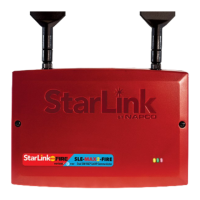StarLink SLE-MAX2-FIRE Commercial Series Sole/Dual-Path Alarm Communicator -- Installation Instructions 9
and blink count for the previous column's SIM slot. The
dBm units (signal level relative to 1 milliwatt) are expressed
in negative numbers. Therefore, the higher the negative
number, the weaker the signal. For example, a reading of -
20 is stronger than -30. The Blinks "blink count" refers to
the corresponding number of blinks on the GREEN RF SIG-
NAL STRENGTH LED "D3," which represents the dBm
level read at the time of the SIM scan.
• Active Slot: The slot/carrier used at the time.
BYPASS SCANNING
Although the automatic scanning of each integral SIM carrier
slot is intended to increase the communication reliability of the
StarLink SLE-MAX2-FIRE, if you wish to bypass the scan/
selection process, or use a "single SIM" mode until communi-
cation is interrupted to force the use of the other carrier, set
the NAPCO NOC Scan Delay After Power Up selection to
"NO Initial Scan", and set the Scan Periodicity to "Turn OFF
Scanning".
After the unit is in this mode, the only way to switch carriers is
by manually initiating a Switch SIM at the NOC website or by
pressing the radio PC board pushbutton (if so equipped). If at
any time a failure of the current carrier network occurs, the unit
will automatically switch to the second carrier. After switching,
the unit will not switch again unless another Switch SIM is
manually triggered or another failure of the carrier network
occurs.
RADIO PCB "DUAL SIM DUAL CARRIER
SUPERVISION" OVERVIEW
IMPORTANT: REQUIRES FIRMWARE VERSION
226.151.XX.X.XX OR HIGHER)
To enhance communication reliability, the StarLink commu-
nicator is equipped with two network carrier SIM card slots
(for Verizon and AT&T) where the communicator supervis-
es both carriers. Fully activated from the factory, the net-
work carrier SIM slots are configured using the
www.NapcoNoc.com Radio Carrier screen (select
Checkins > Dual SIM Signal). Various LEDs on the com-
municator PC boards also provide visual indications, de-
scribed below.
When the communicator is powered, the unit performs its
standard "Checkin" with the NAPCO NOC using the carrier
indicated by the lit LED located next to its SIM card slot.
Five minutes after power up (this is the Scan Delay After
Power Up NOC default setting, described below) the unit
scans each SIM slot carrier, collecting various network sig-
nal quality parameters. During the scan, the yellow LED
(D4) on the main PC board will flash at the rate of one sec-
ond on, one second off.
The communicator will continue to use the initial carrier for 3
hours (specifically 2 hours and 50 minutes) and will then
automatically switch to the second carrier and "checkin".
The Radio Carrier NOC screen will be updated with a sig-
nal data entry report describing the scan status after every
switch.
If at any time the communicator cannot send an alarm or
trouble signal to the central station over the currently active
carrier (or a checkin fails) the communicator will activate
Output 1, switch carriers, and send the alarm/trouble mes-
sage and a Fail to Communicate for the previous carrier to
the central station. After 3 hours, the communicator will
switch back to the previous carrier and send a checkin to
the NOC. If the path is restored, the communicator Output
1 will restore. If the communicator is unable to transmit an
alarm/trouble to the central station the communicator will
periodically send a poll over both carriers and transmit the
alarm/trouble message. After both carriers are restored, the
communicator Output 1 will return to normal.
The NOC Radio Carrier screen also includes the following
buttons:
Scan SIMs
Select to manually start a SIM scan.
Switch SIM
Select to manually switch from one SIM card slot to the oth-
er slot. Note: Alternatively, if the communicator PC board
includes a momentary pushbutton, press/release this button
to manually switch from one SIM slot to the other slot. This
button functions in the same way as this Switch SIM button
in the Radio Carrier screen.
Get SIM Status
Select to request the current status of both SIMs. The re-
sults of each status request are displayed in the Radio Car-
rier screen (see example image on this page). Each row
displays specific dual SIM signal information sent from the
StarLink communicator after every scan, after every switch
slot request, and after every status request. The columns in
this table include:
• Received Time: To determine transmission order, this is
the timestamp the signal was received (displayed as
YYYY-MM-DD HH:MM:SS in 24-hour notation)
• SIM1/SIM2 ICCID: Used for tracking, the ICCID
(Integrated Circuit Card ID) is a unique identification num-
ber assigned to the specified SIM card in the radio PC
board
• SIM1/SIM2 IP address: IP address assigned to the SIM
by the carrier
• Carrier: Displays the previous column's carrier name
• RSSI/Blinks: RSSI (Received Signal Strength Indicator)
and blink count for the previous column's SIM slot. The
dBm units (signal level relative to 1 milliwatt) are ex-
pressed in negative numbers; therefore the higher the
negative number, the weaker the signal. For example, a
reading of -20 is stronger than -30. The Blinks "blink
count" refers to the corresponding number of blinks on the
GREEN RF SIGNAL STRENGTH LED "D3," which rep-
resents the dBm level read at the time of the SIM scan.
• Active Slot: The slot/carrier used at the time.

